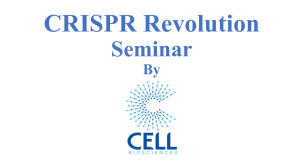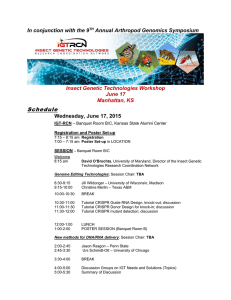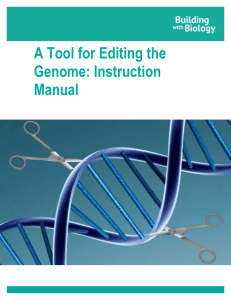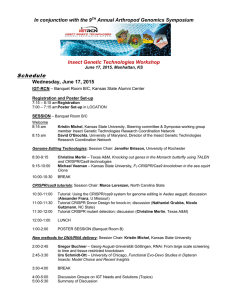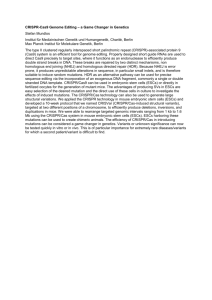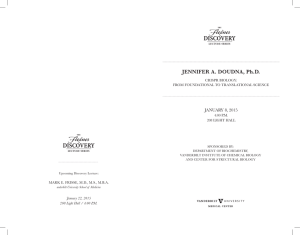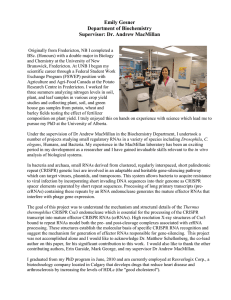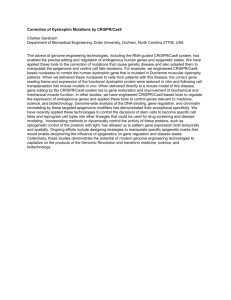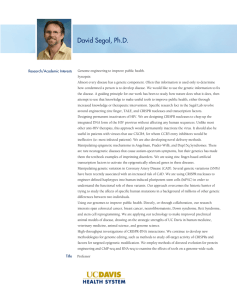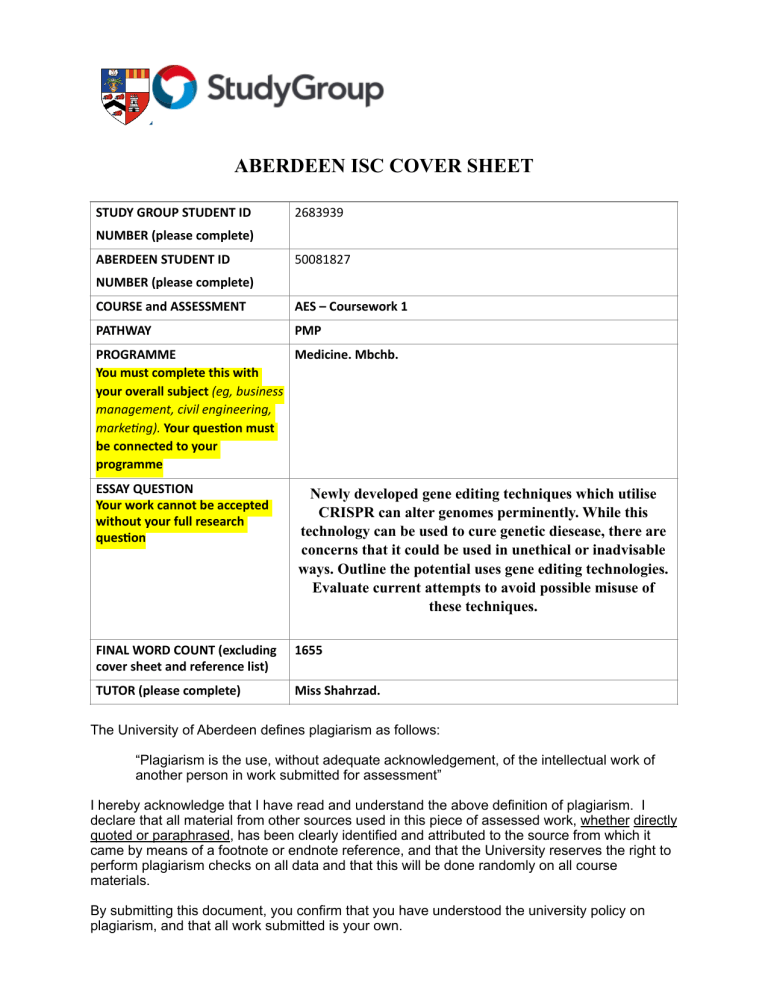
ABERDEEN ISC COVER SHEET STUDY GROUP STUDENT ID 2683939 NUMBER (please complete) ABERDEEN STUDENT ID 50081827 NUMBER (please complete) COURSE and ASSESSMENT AES – Coursework 1 PATHWAY PMP PROGRAMME Medicine. Mbchb. You must complete this with your overall subject (eg, business management, civil engineering, marke ng). Your ques on must be connected to your programme ESSAY QUESTION Your work cannot be accepted without your full research ques on Newly developed gene editing techniques which utilise CRISPR can alter genomes perminently. While this technology can be used to cure genetic diesease, there are concerns that it could be used in unethical or inadvisable ways. Outline the potential uses gene editing technologies. Evaluate current attempts to avoid possible misuse of these techniques. FINAL WORD COUNT (excluding cover sheet and reference list) 1655 TUTOR (please complete) Miss Shahrzad. The University of Aberdeen defines plagiarism as follows: “Plagiarism is the use, without adequate acknowledgement, of the intellectual work of another person in work submitted for assessment” I hereby acknowledge that I have read and understand the above definition of plagiarism. I declare that all material from other sources used in this piece of assessed work, whether directly quoted or paraphrased, has been clearly identified and attributed to the source from which it came by means of a footnote or endnote reference, and that the University reserves the right to perform plagiarism checks on all data and that this will be done randomly on all course materials. ti ti ti By submitting this document, you confirm that you have understood the university policy on plagiarism, and that all work submitted is your own. ID BADGE PHOTO. Name; Nabaa AB Al-qadhi Preferred rst name/nick name; Nina fi Digital photo will be below. Presently ,the endless possibilities of genetic engineering are being more known to the public, the most revolutionary of them being Crispr. However, this type of bio-technology has always been viewed by the scientific community as extremely risky and controversial, this is due to the high level of concern on the ethical issues using it could lead to (Tomlinson, T. ,2018). Therefore, these drawbacks need to be acknowledged, and measures should be taken to reduce the number of unethical experiments using CRISPR-CAS9 that could result in more harm then good to humanity. This essay will summarize the possible aims of gene-editing technologies, and assess the recent undertakings to prevent the probable mishandling of these procedures. This could further ensure a safe usage of this technology is specifically where the most in need and vulnerable can benefit from. CRISPR has piqued the interest of scientists since its discovery in 1993, with the promise of making genome editing more accessible. Jansen I, E., cited in Singh, V and K. What, P. , (2020) initially observed CRISPR’s marvelous linked genes and abilities such that Crispr can alter any gene and cut out harmful genetic codons. This was the outset of a substantial image of a protein code that may be implicated adaptively in the immunity of embryones , giving rise to a technology that has the potential to save many lives. Researchers theorised at the time that because CRISPR technologies are simpler to use and less expensive than traditional gene-editing techniques, they will eventually lead to the democratisation of human genome research. Nevertheless, it wasn't until January 2013 that scientists at the Broad Institute reported that they had successfully programmed CRISPR technology to genome-edit human cells. As a result, Crispr technologies alone enabled researchers to eliminate HIV from living animals, edit out Huntington's disease in mice, decrease the formation of malignant cells,and pave the way for mosquito-borne disease elimination. (Tomlinson, T., 2018). In addition, CRISPR’s abilities were found to help in the the shortage of liver, kidney, and heart donors for youngsters on the organ transplant waiting list. (Kofler, Natalie, and Katherine L Kraschel., 2018). Thereby, Crispr has been shown to have many benefits including a high potential in treating various conditions. Scientists are now putting efforts into attempts of Crispr’s genetic technology in hope of curing numerous genetic and non-genetic diseases. Tomlinson, T., (2018) concluded the most straightforward therapeutic application of CRISPR is in the field of monogenic illnesses including cystic fibrosis, sickle cell disease (SCD), and Duchenne muscular dystrophy. Initially, genetic diseases are caused by a single mutation in the human genome, which means that the disease would not exist if this mutation did not exist. CRISPR's discovery, and its capacity to precisely find and eliminate genetic abnormalities, brings the scientific community closer than ever to the eradication of a number of devastating monogenic disorders. Furthermore, this modern discovered technology has the potential to not only cure many genetic diseases, such as: sickle cell anemia and cystic fibrosis, but also has the potential to cure non genetic diseases like cancer(Luthra, R., Kaur, S., & Bhandari, K., 2021). Consequently, because of its high precision and efficiency (CRISPR) associated protein system has recently emerged as a potent technique for cancer therapy. Akram, Fatima et al., (2020) inferred the biological sciences have reaped several gains from genome editing methods. CRISPR-Cas9 can be used to rapidly design oncolytic viruses and immune cells for cancer therapy. Thus, Crispr has the potential to precisely alter genes not just in model organisms but also in humans, allowing it to be used in various therapeutic research. Crispr has previously been shown by researchers to be capable of permanently removing genetic problems from the whole human genome, as well as genes connected with life-threatening diseases. However, there is a risk that in the wrong hands CRISPR might have a negative impact on human evolution or be exploited to create biological weapons (Tomlinson, T., 2018). The most serious ethical concern is that wealthy people could use these Crispr to improve their physical abilities and features. As a result, subsequent generations and evolution will be forever impacted. Brokowski, C., cited in Betül AYANOLU, F. et al., (2020), stated that when systematically evaluated, some genetically modified nations or populations may preserve a fraction of benefits in comparison to others in terms of a variety of qualities and cognitive abilities.To add on that, the use of Crispr to selectively modify humans for military goals and as a Bio-weapon is becoming a growing issue. The President's Council on Bioethics of former President George W. Bush stated that when performance is crucial, such as with soldiers on the battlefield, human enhancement may be more acceptable (President's Council on Bioethics, quoted in Greene, M., & Master, Z.,2018). With the likelihood of permanent gene improvements in service members, the argument over where the ethical line in army human dynamic provisioning should be set demands further consideration. Research has revealed genes from other species that may presumably be genetically modified to benefit humans.(Gracheva et al., cited in Greene, M., & Master, Z. ,2018). Even a potential gene for Post-Traumatic Stress Disorder has been identified, implying that it may be feasible to erase the emotional detachment that warfighters occasionally experience in the aftermath of a conflict (Cornelis et al. ,cited in Greene, M., & Master, Z. ,2018). If such experiments are ever seriously considered for development, they will very certainly encounter significant regulatory obstacles. Throughout Crispr’s history there had been various high-risk attempts with lethal consequences, the most drastic being an embryo editing. Most prominently, in 2017, researchers from Oregon Health & Science University revealed to have successfully programmed CRISPR to correct a genetic defect associated with heart failure in human embryos. This statement reawakened anxieties of God-playing, and artificial babies, which were repeatedly evoked by opponents of stem cell research in the mid-1990s. The news has heightened the controversy over CRISPR regulation, as the use of foetuses in research is extremely contentious (Tomlinson, T., 2018). Furthermore, another experimentation occurred in Hong Kong in 2018, when a Chinese doctor (He Jiankui) reported the birth of the world's initial genetically altered babies as a result of studies conducted at his institution (Regalado, cited in Morrison, M., de Saille, S., 2019). The revelation was unanticipated and disturbing. Making genetic modifications to the DNA of a human embryo and transplanting it for the purpose of establishing a pregnancy has long been considered a moral threshold, and it is illegal in many places (Araki and Ishii, cited in Morrison, M., de Saille, S., 2019). Morrison, M., and S. de Saille (2019) stated that Crispr infants are both biologically given humans and manufactured experimental scientific objects, which are both not what they were originally supposed to be.Thus, synthetic biotechnologies tend to endanger the symbolic understanding, beliefs, and social rules that enable shared social functioning and organisation. Worry of a community backlash shapes the field in specific ways; even proponents of human enhancement are encouraged to limit the scope of their research to what falls within their so-called social licence to operate. As a result, conviction of immoral scientists such as He Jiankui seemed inevitable in the act of 'detoxifying' a contaminated field. f fi fi fi To prevent the dangerous misuse of Crsipr, governments have developed biosafety guidelines and protocols, as well as proposed a regulatory system in gene editing. Several states have rules restricting human embryo research these strategies range from actively supporting embryonic research to of cially prohibiting all forms of embryonic research (Rossant, J., et al., 2020). For example, experimentation on a living embryo, is forbidden in Massachusetts, as is the development of a fertilised embryo solely for research purposes. Furthermore, the United Nations developed another guideline known as the "Cartagena Protocol” parties are able to notify one of the United Nations' International Biosafety Clearing-Houses, of any activity that could result in the transfer of living modi ed organisms with potentially negative effects. Given the large number of countries that have signed on to the agreement, this "modernization" approach would be a pretty effective means to manage CRISPR on a global scale. (T. Tomlinson ,2018) Nonetheless, privately nanced research are not subject to state regulations, so the government's ability to supervise them is limited. Consequently, new proposals were developed to conquer this issue. One of them is the Coordinated Framework Under this agreement, the FDA would continue to share responsibilities for regulating novel biotechnologies such as CRISPR. For instance, the FDA would continue to have authority over CRISPR-based therapy regimens, and as a result would have authority over genetically modi ied organisms associated with livestock and agricultural products. This regulatory structure offers two key bene its:To begin, a number of existing laws apply to the items that CRISPR may alter. Secondly, the agencies provide businesses with more quick regulatory protection and predictability than is possible with the introduction of new law, both at its inception and today. These mandated restrictions are essential in maintaining a safe environment in genetic technology trials. To conclude, this essay has proved that Crispr has the potential to save the lives of many individuals suffering from many type of diseases, yet, there are many ethical issues and life threatening risks associated with the use of it that need to be considered. Undoubtedly, weighing the benefits and risks of Crispr, this advancement should be handled with high amount of care and consideration such that only the sick get to benefit from it, and that Crispr is prohibited for the purposes of enhancement. Bio-safety protocols are crucial to ensure safe use of Crispr and prevent lethal misuse of such technology. A safe environment for this technological development could be accomplished by following the rules mandated by the government and ensuring the researches are expertise in genetic engineering or have adequate knowledge in the genetic field. Consequently, this would allow for an increase of Crispr benefits and a decrease in morbidity rate. REFERENCE LIST; f Akram F, Ikram Ul Haq, Ahmed Z, Khan H, Ali MS. (2020) CRISPR-Cas9, A Promising Therapeutic Tool for Cancer Therapy: A Review. Protein Pept Lett. Betül AYANO LU, F. , Eser ELÇ N, A. and Murat ELÇ N, Y. (2020) Bioethical issues in genome editing by CRISPR- Cas9 technology. Turk J Biol 44(2),110– 120 Greene, M., & Master, Z. (2018). Ethical Issues of Using CRISPR Technologies for Research on Military Enhancement. Journal of bioethical inquiry, 15(3), 327–335. Kofler, Natalie, and Katherine L Kraschel. (2018) “Treatment of heritable diseases using CRISPR: Hopes, fears, and reality.” Seminars in perinatology vol. 42,8 (2018): 515-521. Luthra, R., Kaur, S., & Bhandari, K. (2021). Applications of CRISPR as a potential therapeutic. Life sciences, Vol. 284. Morrison, M., de Saille, S. (2019) CRISPR in context: towards a socially responsible debate on embryo editing. Palgrave Commun 5(1) , 110 . Singh, V and K. Dhar, P. (2020) Genome Engineering via CRISPR- CAS9 system London : Academic press (2020) İ İ Ğ Tomlinson, T. (2018) ‘A CRISPR Future for Gene-Editing Regulation: A Proposal for an Updated Biotechnology Regulatory System in an Era of Human Genomic Editing’ Fordham Law Review (1) , pp. 440- 482
